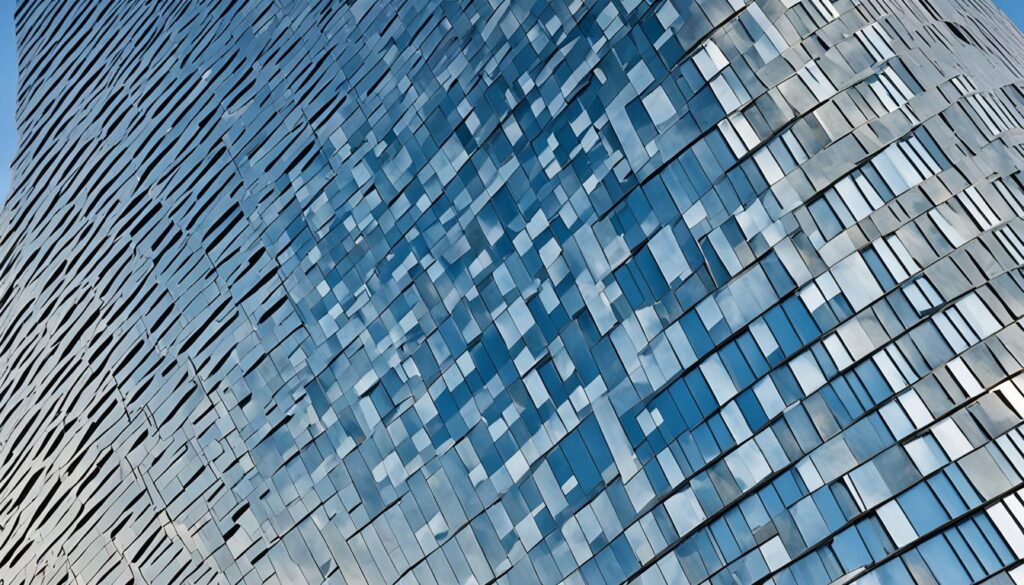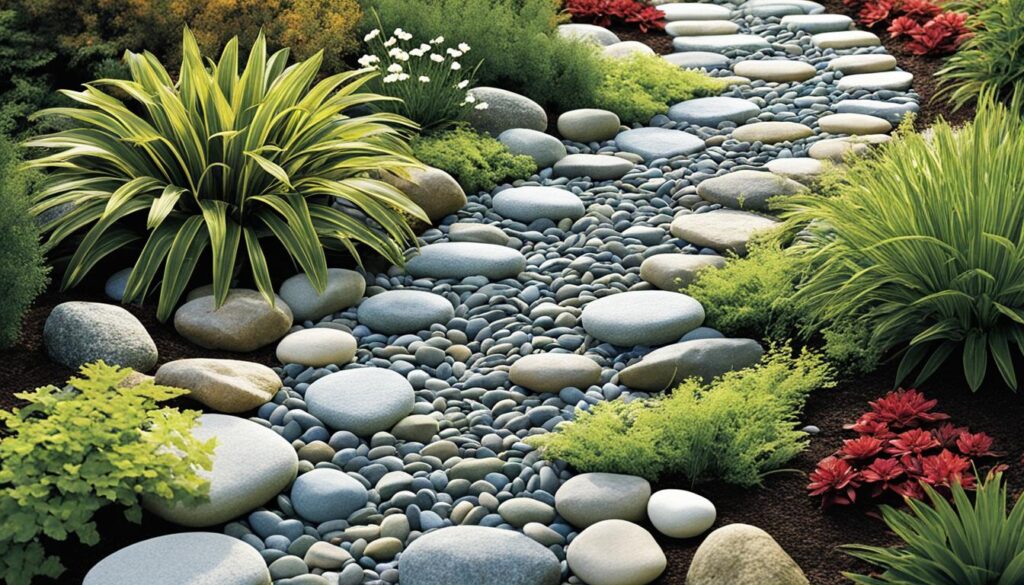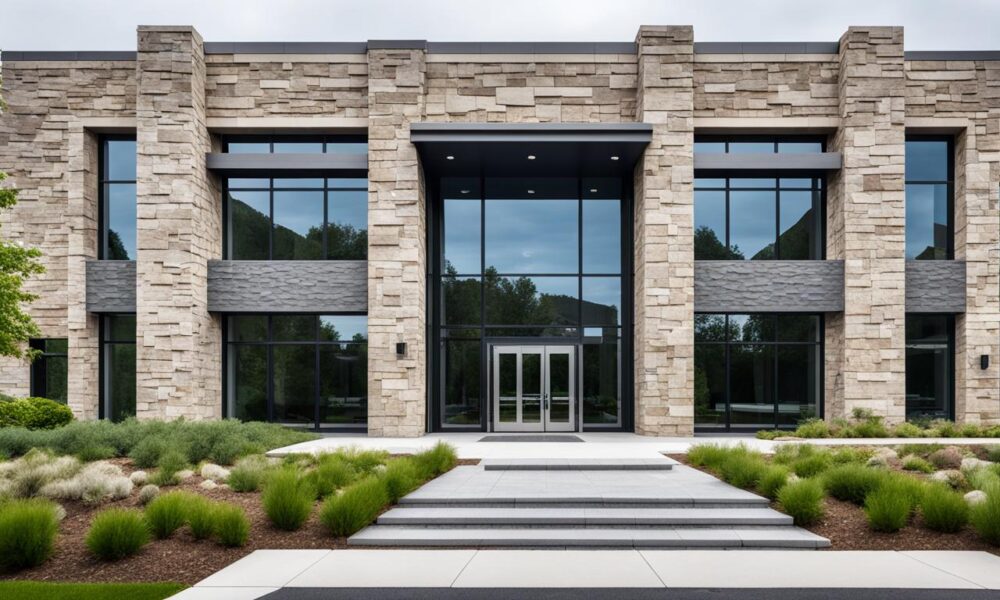Modern Stone Use in Contemporary Architecture
Natural stone plays a vital role in architecture throughout history. From the pyramids of Egypt to structures in Greece and Rome, it’s always been there. Today, modern design celebrates and updates this tradition.
Modern stone architecture merges old ways with new ideas. It’s prized for its strength, green benefits, and unique feel. Natural stone is key in many architectural works, from facades to eco-friendly features.
Key Takeaways
- Natural stone’s historical significance spans from ancient civilizations to modern designs.
- Stone facades offer diverse textures, colors, and patterns, enhancing contemporary architecture.
- Marble, granite, and travertine are popular for stone floors due to their durability and low maintenance.
- Stone’s eco-friendliness makes it a sustainable choice in construction.
- Contemporary uses of stone include building facades, interior decor, and landscaping, balancing aesthetic appeal with functionality.
Timeless Beauty and Durability of Natural Stone
Natural stone is known for its beauty and strength. It has been used in buildings for thousands of years. From Egypt’s pyramids to Rome’s Colosseum, each type of stone adds something special.
Historical Significance
Many ancient civilizations, including the Egyptians, Greeks, and Romans, used natural stone. These materials let them build lasting structures that still stand today. With care, stone buildings can last more than 100 years, beating newer buildings made of concrete and steel.
Modern Aesthetics
Today, designers use natural stone in many ways. Popular stones like granite and marble offer beautiful colors and designs. They’re tough and can be used everywhere from busy floors to elegant building facades.
| Type of Stone | Attributes | Applications |
|---|---|---|
| Marble | Timeless Elegance, Varied Colors | Flooring, Countertops, Cladding |
| Travertine | Rustic Charm, Earthy Tones | Flooring, Garden Pathways, Patios |
| Granite | Durability, Resistance to Wear | Commercial Buildings, Hotels, Driveways |
| Quartzite | Luxury, Unique Patterns | Interior Design, High-End Residences |
Eco-Friendliness
Using natural stone is also good for the Earth. It’s a common material that doesn’t need much processing. And, it can be reused. Buying locally, like from Madhav Marbles and Granite, helps lower pollution from transport.
Building Facades: The Modern Stone Architecture Showcase
In today’s architecture, stone facades show a mix of old and new. They’re more than just beautiful. They push the limits of stone use in buildings. This mix of tradition and cutting-edge tech makes stone facades a unique choice.
Types of Stone for Facades
Many stones are used for building fronts, adding different colors and textures. Marble is still a favorite for luxury designs, despite being less used today. It’s known for its beauty. Limestone and granite are popular for their strength and look. Architects can also make custom stone coverings. This lets them fit stones for any design, creating standout buildings.
Examples of Notable Projects
Around the globe, many buildings show off stunning stone fronts. The Paddenstoelenhuis in The Netherlands mixes concrete blocks with Norwegian marble chips to shine in sunlight. Casa Chaaltun in Mexico blends new and old materials beautifully.
Cornell University’s Milstein Hall in the U.S. has a creative glass front with Turkish marble that looks like a bar code. The Musée d’arts de Nantes in France uses thin marble panels that are dull during the day but glow softly at night.
In Spain, the A&T HOUSE uses recycled marble from local factories. This shows a sustainable building trend. Greece’s One Kleomenous uses advanced technology on traditional marble. Its front has almost 2,300 uniquely cut marble pieces, setting a new standard in stone use.
These projects merge art, function, and care for the environment. They stand as impressive examples of modern architecture using natural materials in creative ways.
Innovative Uses of Natural Stone in Contemporary Architecture
Architects and designers are always looking for new ways to use natural stone. They are finding fresh, innovative ways to use it in modern architecture. This innovation brings new ways to blend nature into our urban spaces.
Non-structural stone curtain walls are an exciting use of stone. They make city buildings stand out while staying practical. These walls show us how traditional materials like stone still have a place in today’s designs.
Inside spaces are also benefiting from natural stone. Walls made of onyx and quartzite are becoming central features in homes. They show us the beauty and durability of stone, adding a wow factor to modern interiors.

Stone is also great for green building. Due to little processing needed and being recyclable, it fits well with sustainable design. It helps with insulation, reducing the need for extra heating or cooling. This shows how stone fits perfectly in eco-friendly projects.
Architects who use natural stone today are keeping its classic beauty alive. They’re also finding new ways to make it useful and visually stunning. This helps us see that stone remains a valuable and adaptable material in architecture.
Structural Support and Longevity
Natural stone is not just pretty; it’s strong and lasts long. That’s why it’s a top pick for holding up big structures in today’s buildings. Stone supports walls, bridges, and tunnels well. Its beauty meets its durability, making it essential in building design.
Load-Bearing Walls
Reliable stone walls are essential to building designs from long ago. These walls, made of natural stone, show how long-lasting they are. They can stand for centuries. A key to their strength is how little water they soak up. This keeps them from wearing out because of the weather. Building them is like investing in a piece of history that will last.
Bridges and Tunnels
Bridges and tunnels made with natural stone can bear a lot of weight over time. Granite, for instance, is tough and long-lasting. It’s often picked for places that get a ton of use, like city curbs. Using strong stone in these projects helps make our cities last longer and pollute less. It also saves on energy. This makes building new things out of stone smart for our planet and our wallets.
Stone Flooring: Elegance Underfoot
Stone flooring is a top pick for many due to its elegance and durability. It’s perfect for both homes and commercial spots. These floors look classy and last for a long time. They add beauty everywhere they are.
Materials Used in Stone Flooring
There are many materials to choose from for stone floors. Premium marble and granite shine with their luxury and strength. Each piece of stone, like marble’s veining and granite’s colors, makes every floor unique.
Granite is tough and can take heat, moisture, and scratches, perfect for busy areas. Marble looks classic, from white to bright colors. Travertine adds a cozy feel but needs sealing to stay free from stains. Limestone offers soft colors but requires more care because it’s not as tough.
High-Traffic Applications
High-traffic stone floors are great for busy places. They last a long time without looking worn. They’re a good choice for businesses and fancy homes because they handle heavy use so well.
Stone floors are easy to keep clean, which makes living spaces healthier. They don’t use plastics, so they’re good for the environment. If a tile gets damaged, you can replace it without redoing the whole floor.
| Stone Material | Characteristics | Ideal Applications |
|---|---|---|
| Marble | Timeless elegance, unique veining, range of colors | Upscale homes, bathrooms, foyers |
| Granite | Durable, scratch-resistant, varied colors | Kitchens, bathrooms, commercial spaces |
| Travertine | Rustic charm, earthy tones, regular sealing required | Living rooms, patios, hallways |
| Slate | Textured surface, dark shades, extremely durable | Indoor and outdoor use, entryways, kitchens |
| Limestone | Soft, muted colors, smooth texture, less durable | Bathrooms, outdoor terraces, low-traffic areas |
Choosing stone floors improves a place’s look and value. They are always in fashion, making them a smart investment. Despite some challenges, stone floors stand out for their beauty, toughness, and easy care.
Landscaping with Stone: A Natural Integration
In landscape design, natural stone blends the human-made with nature perfectly. Its strong beauty works well for many outdoor projects. This approach mixes usefulness with harmony.

Garden Features
Adding stone accents brings elegance to gardens. It turns a simple yard into a peaceful area for people. These designs also help with hills, plant support, and sectioning off parts of the garden.
Outdoor Pathways
Walking paths made of stone fit naturally into outdoor areas. They’re not only beautiful but also last a long time. Options like granite, slate, and limestone stand out for their strength and different looks.
European gardens are famous for using cobblestones or flagstones in their paths. The stones make the gardens look great over many years. The Bhandari Marble Company offers a wide range of stones for such paths.
Thanks to companies like the Bhandari Marble Company, getting quality natural stone is easier. Their selection from India helps create classic or modern outdoor designs. Natural stone in landscaping always sparks creativity and joy.
Interior Design: Bringing Stone Indoors
Stone isn’t just for the outside. It brings a touch of greatness inside too. Look at kitchen countertops and feature accent walls. They shine for their looks and how useful they are. They turn usual rooms into impressive places.
Stone Countertops
Think about the luxury of stone countertops. They make kitchens look better and work better too. Marbles and granites are both strong and pretty. They add a classic charm that lasts, making them a top pick for many.
Accent Walls
Stone walls inside can take a room from nice to wow. Whether it’s bold black marble or soft beige, they make spaces better. They let designers play with different textures and looks. This stops rooms from looking dull and adds a cool style.
Sustainable Construction Practices with Stone
In today’s world, choosing eco-friendly materials is more important than ever. Natural stone is a leading option for green construction. It’s known for its low energy use in extraction and processing. This makes it a top choice for building eco-friendly structures that stand the test of time in both quality and style.
Recyclability
Natural stone excels in being recycled when its original use is over. It can be used again in new building projects or made into various products. This includes things like rockery stones, quicklime, and even toothpaste. Eco-friendly stone practices promote recycling, which cuts down waste and supports a greener future.
Energy Efficiency
One key benefit of natural stone is its ability to keep temperatures steady inside buildings. This can reduce the need for heating and cooling systems. Sustainable quarrying practices further improve its eco credentials. They lessen the impact on the environment through measures like water reuse and modern, green equipment. Also, smarter transport methods help lower the stone’s carbon footprint during delivery.
| Company | Practices | Benefits |
|---|---|---|
| Stamford Stone | Sustainable quarrying, recycling, solar panels | Minimized impact, energy savings, reduced waste |
Stamford Stone leads by example, showing how sustainable business practices benefit everyone. They are open from Monday to Friday, 09:00 to 16:00, with Saturday appointments. This schedule allows them to excel in ethical sourcing and caring for the environment. This effort highlights that choosing eco-friendly stone is a powerful, beneficial strategy in modern construction.
Conclusion
Natural stone is making a big impact on modern buildings. It’s been used for ages but still plays a key role in today’s architecture. This is because it looks great, is strong, and good for the planet. It’s not just for making unusual buildings but also for adding beautiful details inside and out. This shows how ancient beauty combines with new design ideas.
Natural stone lasts a long time and can handle the weather. This makes it perfect for buildings that need to survive for generations. Since it’s good for the environment, buildings made from stone use less energy and stay warm in the winter. Stone isn’t only for looks, it’s also about finding new ways to build with less impact on the earth.
Reusing stone products is a smart way to help the planet. It cuts down on waste and lessens our carbon footprint. By using stones that are local, we help our community and decrease the pollution from transporting materials. Big companies are focusing on making their stone products more eco-friendly. This shows their commitment to sustainability and good design.
As a whole, natural stone is vital for creating beautiful and lasting buildings. It’s about more than just how a building looks. Stone is about supporting our environment and our future. When we use natural stone in architecture, we support a way of building that is good for people and the planet.



